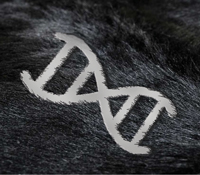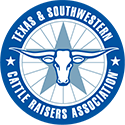Make Better Beef Cattle Decisions with Genomics

By Gilda V. Bryant
Remember when human gene mapping made electrifying headlines in the mid-1980s?
Cattle industry leaders jumped on board to improve the quality of beef and dairy animals. With $53 million in funding, more than 300 scientists conducted genetic research in cattle.
Discoveries about genetics along with advanced computer technology have exploded into genomics.
This branch of molecular biology researches the structure, function and mapping of genes in animals, including cattle, horses and even poultry.
To understand genomics, a simple review of basic genetics is helpful. A calf receives 30 chromosomes from the dam and sire, resulting in a total of 60 chromosomes or 30 pairs. Each chromosome is composed of DNA, the spiral strands of genetic code that determine an animal’s appearance, growth and performance in a particular environment.
Thirty pairs of chromosomes control various functions of the animal. Genes, composed of DNA, control exact functions and are located at specific sites on particular pairs of chromosomes. Every individual always has at least 2 genes for numerous functions, except for the X and Y chromosomes, which determine the animal’s gender. Cattle have nearly 20,000 pairs of genes located on 30 pairs of chromosomes.
Jared E. Decker, Ph.D., assistant professor, state beef genetics Extension specialist and computational genomics division of animal sciences, University of Missouri, says the first DNA test for cattle was ambitious. These early attempts did not work well because scientists were trying to predict a trait, such as marbling, using a handful of genes. Later, they discovered marbling was a complex trait controlled by hundreds of thousands of genes. In the 1970s, statistical models predicted expected progeny differences (EPDs). In 2008, researchers revealed a SNP (pronounced “snip”) chip, which allows breeders to inexpensively test DNA at tens of thousands of DNA markers simultaneously.
“That’s when we really started talking about genomics,” Decker explains. “Instead of trying to look at a small number of genes or a small number of DNA markers, now we’re looking at 50,000 DNA markers. With all those 50,000 DNA markers spread through the DNA of cattle, we were able to create genomic predictions that were actually validated and explained a large portion of the variation in traits.”
The dairy industry began using genomic predictions in 2009 and, in 2010, the American Angus Association (AAA) released their first genomic-enhanced expected progeny differences (GE-EPDs). Currently, many beef cattle breeds have been thoroughly genotyped, thanks to seedstock producers who tested their animals and shared the results. The AAA has more than 400,000 animals genotyped, while the Red Angus Association of America (RAAA) has more than 20,000 animals genotyped. The American Hereford Association (AHA) and breed associations for Beefmaster, Brangus, Charolais, Gelbvieh, Santa Gertrudis and Simmental have also genotyped numerous animals.
Genomics tends to be breed-specific because genomic tests work best in the populations in which they were discovered. Scientists found that some genes have stronger associations with certain traits in different breeds. For instance, SNP markers placed on a marker panel in the Angus population for marbling traits may not signal marbling in another breed.
Putting the data to use
Although seedstock producers have commonly utilized genomic predictions to improve their herds, commercial beef producers can now take advantage of this information. Data received from genetic testing tools allows cattle raisers to make better selection, breeding and mating decisions.
Decker says that commercial producers who are not using EPDs when buying bulls are leaving performance and money on the table. Using DNA testing for genomic predictions allows savvy farmers and ranchers to make even more rapid genetic progress in their own herds. Genetic tools also enable ranchers to utilize younger animals with more confidence, speeding up the rate of genetic improvement and shortening the generation interval.
Genomic testing can predict the occurrence of traits such as growth, calving ease, carcass quality and carcass yield.
A USDA-funded grant, which studied feed efficiency, has enabled several breed associations to launch EPDs for measures of feed intake. Researchers are working on genomic predictions of embryonic loss, bovine respiratory disease (BRD) resistance, water intake and environment-specific EPDs.
“Suppose a producer has been using artificial insemination (AI) and has been producing high-value calves,” Decker explains. “If he simply sells those cattle at the local sale barn, he is selling his superior cattle as an average commodity. Genomic tools can be used to assess the genetic potential of a calf crop. There are programs in place that use genomic predictions to market the calf crop for a premium.”
The average rancher can apply genomics to boost his herd’s genetics by buying bulls that have GE-EPDs, reducing the risk of making an unlucky purchasing decision. Once he makes progress through the bulls, he can test replacement heifers to decide which to keep or sell. If a producer knows the heifer’s genetic potential, he can better choose which bull will complement her strengths and improve her weaknesses.
In commercial ranches, genomic testing removes the need for pedigree information, according to Decker. With genomics, producers now have reliable genetic predictions for commercial cows and calves. When more data is added to the process, the risk is reduced. Genomic testing is a simple way to add more data earlier into the genetic prediction.
Genomics Terminology
By Gilda V. Bryant
Genomics, like every innovative discipline, has developed new terms ranchers need to know, such as:
DNA – strands of genetic code that determine an animal’s growth, performance and appearance.
Gene – a strand of DNA on a chromosome that determines characteristics.
Genotype – the genetic composition of an animal.
Genotyping – the process that tests an animal to determine the particular alleles it carries for a specific genetic test.
Allele – one of two or more versions of a gene. Cattle inherit one allele from each parent.
Simple traits – traits which are controlled by a few genes. Simple traits include coat color, horns or some diseases.
Complex traits – traits, including reproduction, growth and carcass characteristics, which are influenced by numerous genes and the environment.
Locus – the specific location of a marker on a gene.
DNA Marker – a specific DNA variation that can be tested for association with a physical characteristic, such as marbling or tenderness.
Phenotype – the outward appearance of an animal, which is influenced by the genetic makeup of an animal and the environment.
Marker Panel – a combination of two or more DNA markers that are associated with a particular trait.
Expected Progeny Difference (EPDs) – provide estimates of the genetic value of an animal as a parent. Variations in EPDs between two individuals of the same breed predict differences in performance in their future offspring.
Genomic Enhanced-Expected Progeny Difference (GE-EPDs) – GE-EPDs utilize genomic test results in addition to pedigree, performance and progeny data for increased reliability of an animal’s EPDs.
Imputation – using population information to determine missing genotypes.
SNP Chip – a genetic selection test (pronounced “Snip”) which allows breeders to inexpensively test DNA with tens of thousands of DNA markers simultaneously.
An important aspect of genomic testing is the use of EPDs because they accurately measure the genetic merit of an animal. One limitation of EPDs is that researchers do not currently have EPDs for all economically important traits, such as structure and soundness. Decker reports that scientists are working to develop EPDs for additional traits. It is crucial for the seedstock breeder to collect and report complete, accurate data on as many economically important traits as possible.
“EPDs have 2 main advantages,” Decker explains. “First, they separate the total variation in the trait into genetic variation and environmental variation. This allows us to make decisions based on genetics. Second, EPDs are unbiased. In other words, EPDs hit the target; they are accurate. What we call EPD accuracy is a measure of risk, and how much we expect the EPD to change as we collect more data.”
Kelli Retallick, director of Genetic Services with Angus Genetics Inc., a subsidiary of AAA, says commercial beef producers may use genomic testing as a risk assessment tool. In addition to boosting the herd’s genetics, genomics can be utilized as a parent verification tool, especially for commercial breeders who have multi-sire pastures. For example, if a bull loafs instead of covering cows, a producer may decide to replace him.
“Maybe a bull sired a bunch of wild and crazy calves,” Retallick explains. “That’s a bull we don’t want to keep around. [Genomic testing] helps us to identify the sire passing on those traits to his offspring, allowing producers to eliminate the problem.”
On the female side, affordable maternal tests allow commercial producers to benchmark their herd.
“If you can’t measure it, you can’t manage it,” Retallick says. “If you don’t know where your herd’s genetic potential is, how do you make replacement heifer cuts? It’s a really effective culling tool.”
Retallick encourages commercial producers to continue using tried-and-true animal replacement methods in addition to genomic selections. She says it is an additional tool to help producers make better decisions about the bottom third of the herd.
“We can make a lot of progress and return on interest if we get rid of the bottom third of our population and start to move the average of our cow herd genetics in a positive direction,” Retallick explains. “One of the maternal genomic tests the AAA has developed reports ten different individual traits, five maternal and five carcass traits, as well as three economic selection indices. Maternal genomic tests give producers a way to benchmark the genetic value and profitability of their herds.”
GeneMax Advantage, AAA’s maternal genomic tests, costs $28 per head. This expense can easily pay for itself. On 40 head at $28 a head, the producer spends $1,120. If he or she did not test the females and kept 3 animals that did not live up to their performance potential, or failed to get bred because he or she did not have additional genetic information on them, this producer will likely spend more than $1,120 developing the wrong females.
“Our seedstock members are really good at collecting performance data,” Retallick reports. “That makes their EPDs and the genomic predictions within their EPDs more accurate. In return, it allows us to service the commercial industry by providing really high-quality commercial tests.”
To learn more about genomics, visit:
“Better Decisions with Genomics” is excerpted from the February 2018 issue of The Cattleman magazine.
